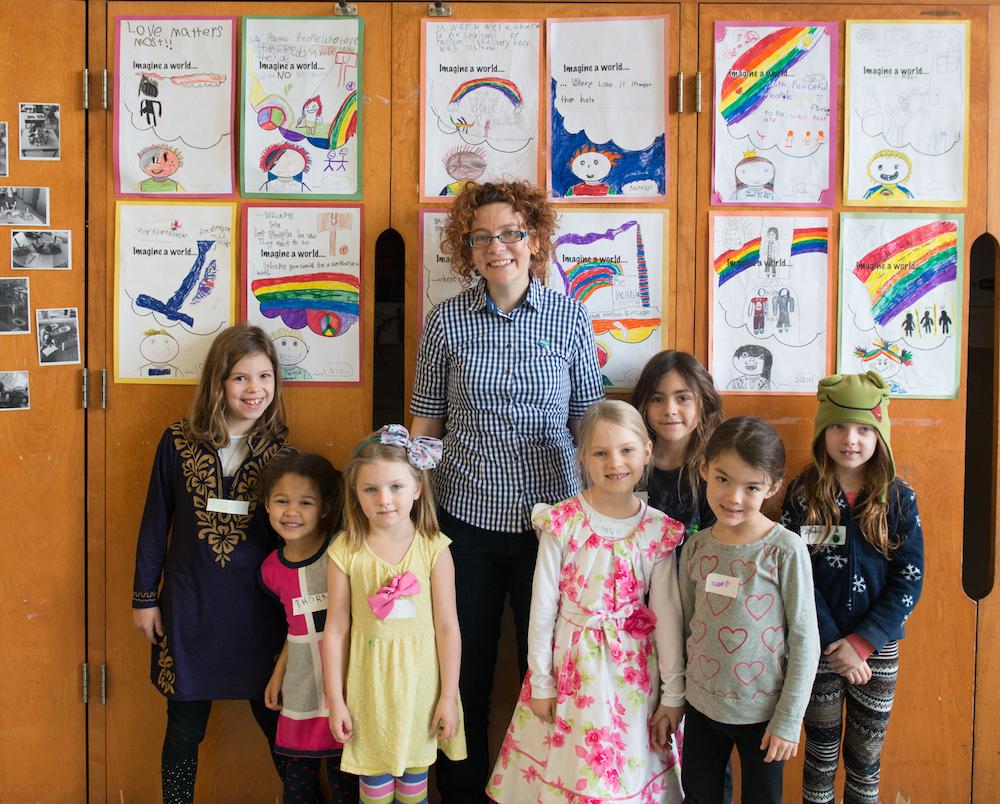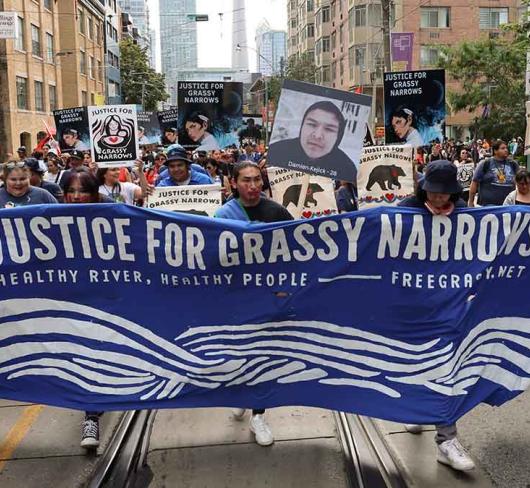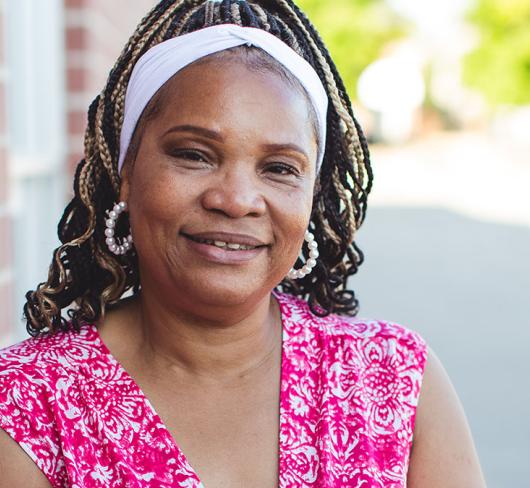
The Stories We Teach
For the last eight years, I have been developing social justice curriculum for kindergarten-Grade 6 students at The Grove Community School. I am learning powerful ways to integrate equity, community activism and environmental justice into the Ontario curriculum through inquiry-based learning and the arts. I am also thinking about what it means to be an ally and the importance of disrupting dominant narratives about colonization, gender, immigration, race, among other issues, not just for those most affected but for everyone. This work in our schools is important because it helps our students become critical thinkers and empowered to make change.
I talk with my students about the fact that the stories we learn do not include all our voices. Storytelling is a powerful tool to help students think critically about whose voices are represented and whose voices are missing in our schools and in our curriculum. These questions can lead to conversations about the impact of not seeing your family reflected in the dominant narrative and questions about how these stories support hierarchies of power. Who benefits from these stories? How does a story support or disrupt power structures? In her TED Talk, “The Danger of the Single Story,” feminist author Chimamanda Ngozi Adichie argues that “We cannot talk about storytelling without talking about power.” Educators may be reluctant to explore the impact of power and privilege in our schools, but this work is necessary if we are going to challenge the unexamined oppression and racism in the stories we tell.
In “Teaching Treaties as (Un)Usual Narratives: Disrupting the Curricular Commonsense” Jennifer Tupper and Michael Coppelo describe curriculum as “the collective story that we tell our children about our past, our present and our future.” The Eurocentric curriculum we teach in Ontario reflects the values of colonization, which privileges the lived experiences of white people and silences racialized and Indigenous voices. The history we teach reproduces stories of dominance and entitlement and attempts to justify the illegal occupation of Indigenous land. This narrative of white supremacy has been maintained for hundreds of years by Canadian government, legal, political and criminal justice systems, by educational institutions and by the media. Disrupting the dominant narrative is essential to social justice education.
DISRUPTING THE DOMINANT NARRATIVE
At the Grove Community School we organize assemblies and activities where students can learn about colonization, racism, sexism, homophobia, power and privilege. We invite guest speakers from different communities to our school. This work creates safe and inclusive spaces for everyone.
We begin each year by working in collaboration with students to co-create inclusive and positive classroom agreements to support self-love and knowledge. The activity is called “Strengths and Struggles” and is integrated curriculum about accessibility and identity that recognizes the different ways we learn and respects that we all have strengths and struggles. Using picture books and media texts, students learn about children with different abilities and begin to recognize that everyone is able. Inviting a guest speaker to share their story and/or participating in the Terry Fox Run enriches this curriculum. Students explore the local community to identify, describe and collect data about different types of barriers. The Grade 1 and 2 students use inquiry to investigate how ramps increase accessibility for people in wheelchairs and make connections to other accommodations that support integration and inclusion.
Social justice education includes creating opportunities to celebrate community and family pride. Every year, the Grade 3 students complete a research project called “Tracing our Family Roots/Routes.” The learning goals of this project include honouring our diverse family journey stories and deepening our understanding that, with the important exception of First Nations, Inuit and Métis families, many of our families have lived in other places before arriving and settling in Canada. Students work with their families to document the different places they have lived and investigate the forces that “pushed” or “pulled” their families to leave home. Every student shares their family journey story as an oral presentation. The ensuing discussions are powerful. These projects allow us to make connections between struggles in the past and in the present, such as racial discrimination, poverty and war, and disrupt dominant narratives about immigration and settler experiences.
Strengthening our relationship to each other and to the land is an important part of our learning. “Seeds of Change” is an example of curriculum that integrates environmental justice with community activism. Students explore land-based education and focus on equity and environmental sustainability. We read the biography of Wangari Maathai as inspiration for our learning together. Her story of resistance teaches us about the power and strength of community and advocacy and motivates us to plant our own seeds of change. Together, we learn about the local environment and focus on the responsibility we all have to share and care for the resources of this land. Students learn about environmental racism and communities that do not have access to clean water, including many Indigenous communities in Ontario. Students share their learning and raise awareness about issues connected to the land through announcements, posters and social action.
It is important to teach students about current social movements such as “Idle No More” and “Black Lives Matter” and to learn about political activists working to resist oppression, including Dr. Cindy Blackstock, Vandana Shiva, Naomi Klein, Desmond Cole and Maude Barlowe.
In March, we acknowledge the International Day for the Elimination of Racial Discrimination. Gathering in March gives students a chance to share what they’ve learned during Black History Month and encourages educators to make connections among communities that have experienced and continue to experience racial discrimination. It is an opportunity to examine the big ideas of privilege and exclusion and understand the ways power is maintained by systems of oppression. If we want to work together to eliminate discrimination, we need to actively confront systemic oppression and think critically about what it means to be an ally.
“Gender Splendour Week” is an annual exploration of gender equity, inclusive families, and the impact of homophobia and transphobia. Every April, students work in multi-aged groupings to examine gender stereotypes and critically consider gender binary roles in our society. In the last seven years, we have created social justice curriculum about the LGBTQ movement and the symbolism of the rainbow flag, the addition of “gender identity” and “gender expression” to the Ontario Human Rights Code, and what it means to be a “feminist.” After learning about Malala Yousafzai and listening to her address the United Nations about girls’ inequitable access to education, the grade 4-6 students wrote statements of solidarity to post in the hallway. This curriculum creates meaningful opportunities to explore media texts, identify different points of view and explore the big idea in musical lyrics. The songs “True Colors” and “Stereotype” are always part of our celebration. They remind us how powerful our movements are when we join our voices in solidarity.
On June 11th, our students participate in an annual letter writing campaign called “Our Dreams Matter Too” in solidarity with and support of First Nations children living on reserves who do not have equitable access to education and health resources. The determination of Shannen Koostachin moved us to share our feelings with our local Member of Parliament and to write letters to the Prime Minister of Canada. These actions help students feel empowered and give them a voice to speak out against systemic injustice.
CONCLUSION
At the Grove, we are lucky to have an explicit focus on social justice education but, as educators, we need to believe this work is important for all of us to do. We need to be willing to take risks and make mistakes. We need to make connections and think creatively about how we can “uncover” the curriculum with our students. It is our responsibility to share stories that are not our own and to acknowledge that events are perceived differently by different people. Stories are never objective.
Becoming an ally is an ongoing process that requires critical reflection about the stories we bring into the classroom. It means acknowledging that the privilege we have to teach comes with a responsibility to actively decolonize our schools and disrupt the colonial narrative. Becoming an ally means recognizing that we are all complicit in the systems we are trying to resist. It means listening and working together for justice. Social justice education includes implementing curriculum that empowers students to feel proud of their stories, and at the same time, challenges students to begin thinking through the systems of oppression that maintain power and privilege. This work can feel overwhelming at first, but it is the most important work we can do.
Velvet Lacasse is a member of the Elementary Teachers of Toronto.

